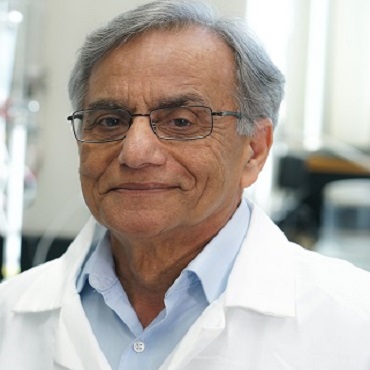Scientific Program
Keynote Session:

Dr. Kailash Chada
Emeritus Associate Professor of Oncology, Roswell Park Comprehensive Cancer Center, USATitle: KAPS-biomarker for early diagnosis of Prostate Cancer
Biography:
Dr.Kailash Chadha graduated from University of Guelph, Guelph, Ontario, Canada and completed his postdoctoral work as a fellow of National Research Council of Canada. He has actively participated in teaching several courses at Roswell Park including Interferons & Cytokines, Molecular Biology of Animal Viruses, Recent Advances in Biochemistry of Neoplasia, Histocompatibility and Immunobiology.
Abstract:
Prostate cancer (CaP) is the most common non-skin cancer in men and third most common cause of cancer deaths in men. Black men experience a higher burden of incidence and mortality from CaP compared to White men. The Prostate-Specific Antigen (PSA) test, a commonly used biomarker for early diagnosis and management of CaP, cannot alone accurately predict the presence of CaP, its aggressiveness, or the risk of post-treatment recurrence. The widespread use of PSA testing in CaP screening is controversial partially because patients with benign enlargement of the prostate often have elevated levels of PSA and many men with diagnosed CaP have a normal PSA. Consequently, a search for more effective prostate tumor biomarkers is overdue. Our studies thus far show that concurrent measurements of the levels of serum cytokines such as IL-8, TNF-α, and sTNF-R1 (KAPS biomarker) provide a significant advantage as a CaP biomarker over PSA measurements alone in differentiating men with CaP from men without CaP. Our working hypothesis is that both Black and White men with CaP have altered circulating levels of KAPS biomarker compared to men without CaP. Further, the extent to which these levels are altered will vary according to CaP risk factors and can be used as a tool to improve the early detection of CaP and CaP treatment decision-making. We tested our hypothesis in a retrospective study of men with elevated PSA but a negative prostate biopsy, patients diagnosed with localized prostate cancer and patients with castration resistant CaP (CRPC). The predictive accuracy of the markers was described using receiver operating characteristic (ROC) curves. In our analysis, AUC values greater than 0.8 were considered as useful in predicting CaP outcomes for individual patients. All the comparisons for KAPS biomarker were statistically significant at the p<0.05 level. The AUC for each of marker alone was statistically superior to PSA alone (p<0.01 for each pairwise comparison). Each of the KAPS-marker combination AUCs was significantly better than PSA alone (p<0.01 for all), but not statistically different from each other. Combining TNF-α with PSA resulted in a 3.0-fold decrease in the PSA-Alone False Positive Fraction (FPF), and a 3.7-fold decrease in the PSA- Alone False Negative Fraction (FNF). The PSA+sTNFR1 combination had a 5.9-fold decrease in the FPF, and a 2.5-fold decrease in FNF. Ability of KAPS-biomarker was also effective at distinguishing between localized CaP and metastatic CaP patients. AUC results (with 95% confidence intervals) for additive combinations of these biomarkers will also be discussed. The best predictor of localized CaP vs. metastatic CaP was KAPS combined with PSA 0.999 (0.998 to 1.000). Due to the reported significant racial differences in the diagnoses of and mortality from CaP, future CaP biomarker studies should include a racially diverse sample of men, especially Black men.
Title: Cancer Prevention and Therapy of Two Types of Gap Junctional Intercellular Communication–Deficient “Cancer Stem Cellâ€
Biography:
James E. Trosko, founder of Trosko lab has focused on the mechanisms of carcinogenesis and mutagenesis. His initial research involved the study of radiation-induced mammalian mutagenesis. Recently he discovered biomarkers for adult human stem cells that has provided strong evidence for the "stem cell theory" of cancer.
Abstract:
Early observations showed a lack of growth control and terminal differentiation with a lack of gap junctional intercellular communication (GJIC). Subsequent observations showed that epigenetic tumor promoters and activated oncogenes, which block gap junction function, provide insights into the multi-stage, multi-mechanism carcinogenic process. With the isolation of embryonic induced pluri-potent stem cells and organ-specific adult stem cells, gap junctions were linked to early development. While tumors and tumor cell lines are a heterogeneous mixture of “cancer stem cells†and “cancer non-stem cellsâ€, the cancer stem cells seem to be of two types, namely, they express (a) no connexin genes or (b) connexin genes, but do not have functional GJIC. These observations suggest that these “cancer stem cells†originate from normal adult stem cells or from the de-differentiation or re-programming of somatic differentiated cells. This “Concept Paper†provides a hypothesis that “cancer stem cells†either originate from (a) organ-specific adult stem cells before the expression of the connexin genes or (b) organ-specific adult stem cells that just express gap junction genes but that the connexin proteins are rendered dysfunctional by activated oncogenes. Therefore, cancer prevention and therapeutic strategies must account for these two different types of “cancer stem cellâ€.
Title: High aldehyde dehydrogenase levels are detectable in the serum of patients with lung cancer and may be exploited as screening biomarker
Biography:
Dr. Alessandra Rossi earned her M.Sc in biology, with specialism in molecular biology, at the Department of Pharmacology at the University of Bologna. There, she performed her PhD thesis at the Department of Human Pathology studying the molecular mechanisms of retinoic acid derivatives in cancer models. After earning her specialization in pharmacology, she worked as a postdoctoral scientist at the University of Siena and Temple University (Philadelphia, PA, USA), where she had the opportunity to apply her research skills in several projects that included the screening and profiling of anti-cancer compounds and the elucidation of new anti-cancer properties of molecules already in the clinic. After having worked for two years in the medical affairs at the pharmaceutical company Eli Lilly, she joined the University Medical Center Eppendorf of Hamburg, where she focused on the development of targeted Next Generation Sequencing approaches for mutational profiling of plasma cell dyscrasias and analysis of liquid biopsy in solid tumors. Currently, she is in the scientific committee of Luigi and Teresa de Beaumont Bonelli Foundation for Cancer Research, is working as a nutritionist for cancer patients and as a researcher at the University of Bologna, where she has been working on the evaluation of potential screening biomarkers for lung cancer.
Abstract:
Since early detection improves overall survival in lung cancer, identification of screening biomarkers for patients at risk represents an area of intense investigation. Tumor liberated protein (TLP) has been previously described as a tumor-associated antigen (complex) present in the sera from lung cancer patients. Here, we set out to identify the nature of TLP to develop this as a potential biomarker for lung cancer screening. Materials and Methods: Beginning from the peptide epitope RTNKEASI previously identified from TLP complex, we produced a rabbit anti-RTNKEASI serum and evaluated it in the lung cancer cell line A549 by means of immunoblot and peptide completion assay (PCA). The TLP sequence identification was conducted by mass spectrometry. The detected protein was, then, analyzed in patients with non small cell lung cancer (NSCLC), benign lung pathologies and healthy donors, by ELISA. Results: The anti-RTNKEASI antiserum detected and immunoprecipitated a 55kDa protein band in the lysate of A549 cells identified as aldehyde dehydrogenase isoform 1A1, revealing the molecular nature of at least one component of the previously described TLP complex. Next, we screened blood samples from a non-tumor cohort of 26 patients and 45 NSCLC patients with different disease stages for the presence of ALDH1A1 and global ALDH. This analysis indicated that serum positivity was highly restricted to patients with NSCLC (ALDH p<0.001; ALDH1A1 p=0.028). Interestingly, the global ALDH test resulted positive in more NSCLC samples compared to the ALDH1A1 test, suggesting that other ALDH isoforms might add to the sensitivity of the assay. Conclusion: Our data indicate that ALDH levels are elevated in the sera of NSCLC patients, even with early stage disease, and may thus be evaluated as part of a marker panel for non-invasive detection of NSCLC.
Title: Immunotherapy in Lung Cancer
Biography:
Dr. Rajat Bajaj is a Medical Oncologist practicing in New Delhi, India. He has an experience of over 6 years in the field of Oncology. Dr Bajaj completed his MBBS and MD Internal Medicine, both from the prestigious Maulana Azad Medical College in Delhi. Then he did his DNB Medical Oncology Super specialization from the renowned Rajiv Gandhi Cancer Institute and Research Centre in Delhi, which is considered the apex center of India for cancer treatment and research. Dr Bajaj has been actively involved in various research and training programs in his field of medical oncology across India. He has also got trained in advances in immunotherapy (Singapore) and breast cancer (Berlin, Germany). He has been certified in Medical Oncology by European Society of Medical Oncology (ECMO). Dr Bajaj is a part of multidisciplinary team of cancer treatment at his hospital. He has special interest in treatment of solid malignancies by targeted medicines, infusional biological therapy, oral TKIs and immunotherapy. He has presented his research work as speaker on many occasions and published his work in many international and national journals of good repute.
Abstract:
TBA (Power point presentation)
Oral Session 1:
- Biomarkers | Prognosis, Diagnosis and Prediction | Lifestyle and Medication | Cancer Therapies and Therapeutics | Immuno-Oncology | Molecular Genetics | Drug Development | Nanotechnology for Biomarkers | Emerging Therapeutic Biomarkers
Title: Method to Prevent Early Relapses in Cancer
Biography:
Michael Retsky completed his PhD in experimental physics from University of Chicago in 1974. He was doing physics research at Hewlett-Packard in Colorado Springs. After a friend's wife was diagnosed with cancer, an informal research group began that eventually captured Retsky's interest more than physics. He made a career change to cancer research in 1982. He was Prof of Biology at University of Colorado and Visiting Prof at University of Texas- San Antonio. He is now on staff at HSPH and has a small business start-up focusing on late relapses. He has three patents pending. He has published over 90 papers in physics and oncology. He edited a book titled Perioperative Inflammation as Triggering Origin of Metastasis Development, published by Springer Nature in 2017.
Abstract:
Most current cancer research aims to prevent cancer patients from dying from metastatic disease. My colleagues and I aim to solve the problem upstream, i.e., to prevent relapses. We were confronted some years ago with the unexpected observation of bimodal relapse patterns in breast and a number of other cancers. This was not consistent with the current cancer paradigm that has guided early detection and therapy for many years. Our multidisciplinary colleagues include surgeons, medical oncologists, anesthesiologists, biologists and physicists. After much analysis including computer simulation and input from these medical and scientific specialists, we eventually came to the conclusion that surgery to remove the primary tumor produces systemic inflammation for about one week after the surgery. This systemic inflammation caused dormant single malignant cells and avascular micrometastases to exit from dormancy and result in relapses in the 3 years after surgery. Those relapses comprised the early peak. We have determined that in breast cancer 50 to 80% of relapses (increasing with tumor size and positive nodes) are in the early peak so an effective method to prevent these relapses would be extremely important. It was then determined in a retrospective study that the common inexpensive perioperative NSAID ketorolac can prevent the early relapses. A second retrospective study strongly confirmed this result but a small prospective study found no advantage. Recent developments include a study by Krall (Science Translational Medicine 2018) that demonstrated a mouse model that supports our hypothesis.
Title: Environmental exposure to organophosphate pesticides during pregnancy: early biological effects and biomarkers evaluation in non-invasively collected matrices
Biography:
Dr. Gladis Magnarelli granted Biochemistry degree (University of Córdoba,Argentina) and post-degree in Biochemistry (South University, Argentina). Since 1978 she worked in the National Comahue University, Argentina, being professor of Biochemistry at the Faculty of Medicine during seventeen years. She published more than 30 articles in peer reviewed journals and authored few chapters in books. Four students were awarded Ph.D. degree and four Master degree under his guidance and supervision. She carried out university extension tasks for the training of health agents in environmental health prevention. At present Dr. Magnarelli is assessor of Research Project .
Abstract:
The collection of invasive samples from susceptible populations such as pregnant women and newborn, suffers from ethical and practical limitations. Besides, the accumulation of exposure data will be unsuccessful for risk assessment if not integrated by early indicators of possible health effects. Transverse studies were conducted to evaluate the impact of organophosphate pesticides (OP) exposure in residents of agricultural areas (RG:rural group) and the usefulness of exposition/effect biomarkers. We collected at term placental villous (PV) and umbilical cord blood (UCB) samples during both spraying (SS) and non-spraying seasons (NSS) and from urban residents (control group). In SS, PV showed decrease carboxylesterase (CaE) activity, suggesting OP reached the placenta. Syncytiotrophoblast mitochondrial cardiolipin content and Cytochrome c oxidase activity (1) increased. Arginase and ornithine decarboxylase, involved in tissue repair mechanisms, were induced and inverse associated to CaE(2). Changes could represent a response to OP induced injury being mitochondria bioenergetics and steroidogenic function, a toxicity target. Reduction in Progesterone level and endothelial nitric oxide synthase expression may account for low newborn weight in RG (1). Although PV was able to handle the prooxidant conditions that might have been generated in SS, an inverse  association between Catalase (CAT) activity and placental Ãndex was found. (3). Placental CaE and CAT  have a potential as exposition and susceptibility biomarker, respectively. UCB erythrocyte osmotic fragility and superoxide dismutase activity changed and the DNA damage index increase (4). Impact on the UCB antioxidant defense capacity may contribute to increased vulnerability to oxidative insults since intrauterine life






